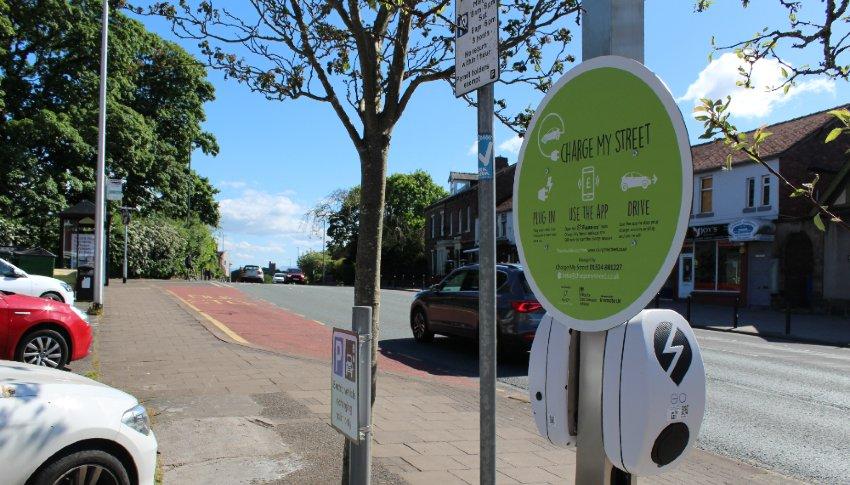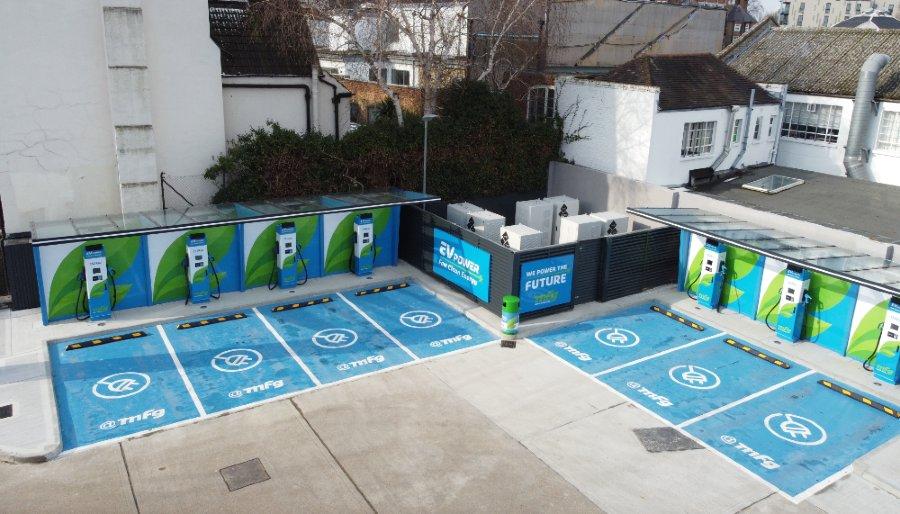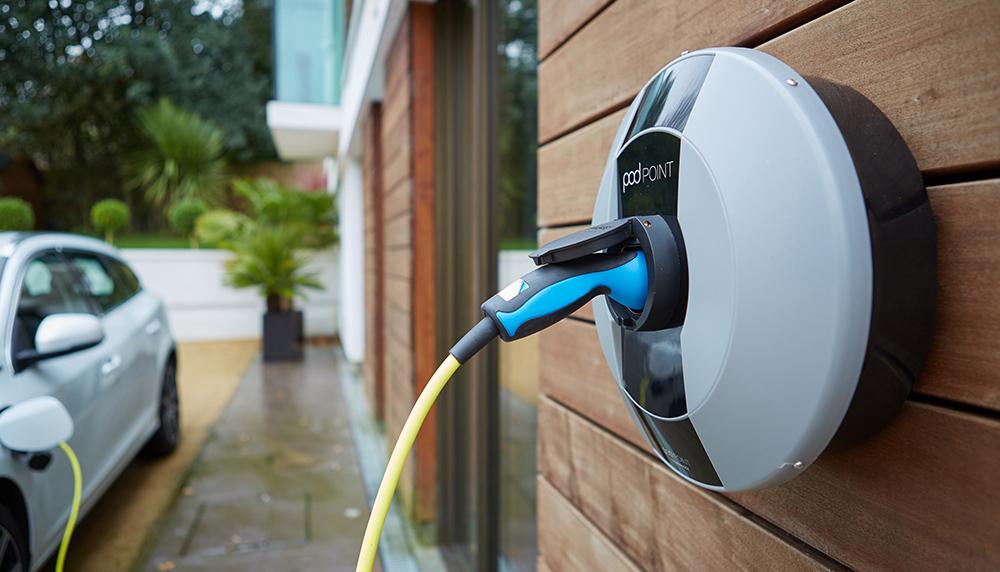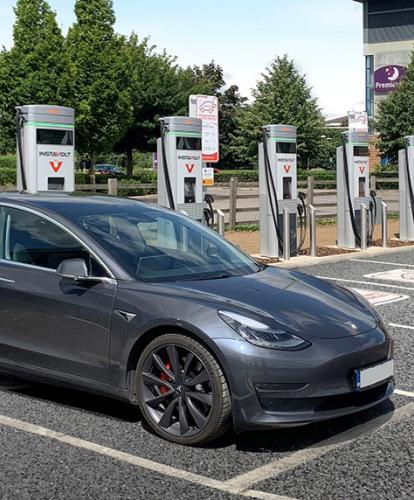In the first quarter of 2022, the UK will hit 30,000 electric vehicle (EV) charging devices. It’s only been a few months since we passed the 25,000 mark, but rapid growth in charging infrastructure across the country has been a characteristic of 2021 – and we can make this prediction, at least, with certainty.
However, charging provision in the UK currently presents a complex picture. New charging locations, devices and connectors appear on a daily basis. They will continue to do so in 2022, but how will next year be different to 2021? What can we expect to see from EV charging over the year ahead?
For starters, providing adequate charging infrastructure across the UK in 2022 will require more than hitting milestones. Getting it right isn’t necessarily easy, but can certainly be done. Here’s what the team at Zapmap thinks is coming for electric vehicle charging in 2022.
Charging an electric vehicle on the public network in 2022

Growth in EV charging infrastructure
If you take data from the first three quarters of 2021, you’ll see an impressive growth in public charging infrastructure. Some areas, however, grew more than others.
First, between the beginning of January and the end of September, the number of ultra-rapid charging devices in the UK increased by more than 50%. These are 100kW+ chargers, and EV drivers can add more or less 80 miles of charge in around 15 minutes.
Second, and even more impressive, was the growth in low-powered slow charging devices. These are typically on-street charging devices, important for overnight or ‘base’ charging. Over the same period, the number of these slow devices increased by 66%.
It is in these two areas, ultra-rapid (giving EV drivers the fastest charging experience) and slow charging – low-powered, on-street charging as a replacement for home chargers – that we can expect to see strong and continued growth over the course of 2022.
More ultra-rapid charging hubs
With the ultra-rapid devices, you need only look back at some of the announcements made this year to see that there will be many more available to EV drivers in 2022.
Motor Fuel Group, for example, plans to install a total of around 3,000 ultra-rapid 150kW and 350kW chargers across its MFG EV Power network by the end of 2030. Osprey is also planning to install more than 150 high-powered EV charging hubs across the UK by 2025 – some have already opened. GRIDSERVE and InstaVolt have made similar announcements.
These ultra-rapid devices are prime examples of ‘en route’ charging, when you want to charge your car as quickly as possible. Due to this, and because drivers want to be confident that such devices will be available to use upon arrival, we’ll increasingly see ultra-rapids springing up in groups – or charging ‘hubs’ – of around six devices.
More slow charging devices
The second area in which we’ll see strong and continued growth next year is the provision of low-powered chargers ideal for overnight charging. Many of these devices, often found on residential streets or as part of community projects, act as a replacement for home charging. With people increasingly making the switch to electric, more and more of the roughly 40% of people in the UK who do not have access to off-street parking will need to rely on this type of public infrastructure.
Indeed, with demand in this area growing, charge point operators have already moved in to fill the gap. Connected Kerb, for instance, has announced plans to install 190,000 public on-street chargers by 2030. The investment specifically aims to provide access to EV charging for millions of drivers without off-street parking. Similarly, Shell is planning to install 50,000 slow ubitricity chargers in the UK by 2025.
Zapmap prediction: We will pass the 40,000 devices mark in 2022. Rapid and ultra-rapid charging devices will top 7,000, while slow and fast devices will number more than 35,000.
Changes from charge point operators

‘Peak CPO’
There are currently around 70 charge point operators, or CPOs, in the UK – although 13 make up around 75% of all chargers. (See our statistics page for more details.) It’s a new and dynamic market, not to mention fragmented.
As we move into 2022 and beyond, we can expect to see the beginnings of consolidation. Some will enter administration. There will be takeovers and mergers. But, as in 2021, there will also be new players still entering the charging space. As a result, 2022 will likely see the UK reach a peak in terms of the number of CPOs in play before the market begins to feel less fragmented – for the EV driver at least.
In any case, whatever the number of CPOs in operation next year, what can we expect to see from them?
Charge point pricing
“Looking ahead to 2022, I don’t think I’ll be alone in expecting to see hikes in pricing from charge point operators across the country, not least because of increases in wholesale energy prices,” says Alex Earl, Commercial Director at Zapmap. “We’ve already seen some operators take this course of action, and I wouldn’t be surprised if others join them.”
The expectation here, according to Earl, is for 40p and above per kWh to become the norm for EV charging, at least for ‘en route’ hubs.
“On that note, we’re also likely to see prices splitting out to reflect specific charging speeds,” he continues. “So you’ll see one price for your ultra-rapid chargers, one for rapid, and others for fast and slow devices.”
On top of increases in wholesale energy prices, this disaggregation of pricing for charging speeds will also be driven by operators trying to recoup on costs. Installing – and running – ultra-rapid chargers, for example, is more expensive than for slow devices.
Another trend he sees on the horizon, although not until 2023, is for dynamic pricing. Also known as time-of-use pricing, this would involve operators charging higher prices at times of greater demand.
Zapmap prediction: 50kW chargers will become a thing of the past. (100kW+ will become the norm, while slow and fast chargers will fulfil different needs.)
The EV driver experience will be critical

Zapmap’s recent EV charging network rankings, as rated by EV drivers, show once again that a good charging experience primarily hinges on the charging device being reliable and easy to use. Moving into 2022, these two factors will therefore be key priorities for the UK’s public charging networks.
“Although the survey shows that some networks are indeed delivering a frictionless charging experience, others have work to do,” says Melanie Shufflebotham, Co-founder & COO at Zapmap.
“The experience of the EV driver should be front and centre for all CPOs in 2022, and with increasing numbers expected to switch to electric next year, making public charging simple will become more important than ever.”
As well as getting chargers into the ground in 2022, CPOs that are in it for the long run will focus on improving the solutions they offer, combining ease of use, reliability and good customer service to create a seamless charging experience for drivers.
As the top three networks have shown in this year’s rankings, this can undoubtedly be achieved. And one aspect that helps to facilitate success here is cooperation.
Paying for EV charging
“Next year I can see the charging networks being more open to solutions such as cross-network payment,” says Shufflebotham. “I think they’ll be more ready to engage across the board, in order to provide great solutions for EV drivers.”
One such solution is of course Zap-Pay, the simple way to pay for EV charging across networks from within the Zapmap app. With seven more networks having signed up in 2021, MFG EV Power and GeniePoint are now scheduled to go live in the New Year, joining Osprey, ESB Energy and char.gy and making thousands more chargers Zap-Pay enabled for EV drivers across the country.
EV charging and parking
It won’t just be in payment, however, where solutions for charging lie. We can also expect to see more in 2022 around peer-to-peer charging, from the likes of Co Charger and JustPark.
“From my perspective, I wouldn’t be surprised to see further movement from the parking industry into the charging space,” says Earl. “It makes sense in many ways for the two industries to converge, at least in part, and I think the nuances of how this will actually work will become apparent over the course of 2022.”
Zapmap prediction: The focus will shift to the consumer and to ease of use, with simple cross-network payment available across the majority of the key networks.
Electric fleets will boom in 2022
Another key focus next year – for businesses – will be on fleets. For starters, we can expect to see huge growth in EV fleets as the fleet market catches up with the consumer sector.
“In particular, companies will increasingly want to get a handle on the costs and emissions of fleets that may well include a combination of fully-electric, plug-in hybrid and fossil fuel vehicles,” says Earl.
“Understanding the logistics of keeping mixed fleets such as these charged up and operational will definitely be on the agenda next year.”
Part of the complexity here will come from the variety of charging options available for electric fleets, with drivers increasingly able to charge their vehicles at work, at home and on the road.
One of these complexities will be how to pay for charging, which is why Zapmap has partnered with FleetCor to launch Zap-Pay Allstar payments in early 2022 and provide a seamless payment solution for fleets with EVs. An Allstar One Electric account, for instance, not only gives fleet managers one clear overview of all fuel costs, but simplifies admin for all transactions across all fuel types, and provides full visibility of spend across fleets.
Of course, it’s not only about paying for charging. There are other factors around fleets that companies will need to consider too.
Carbon reporting for fleets
“With businesses under pressure to reduce costs and lower their carbon footprint, I think we’re on course to see a boom in EV fleets during 2022,” says Ben Lane, Co-founder & CTO at Zapmap.
“Companies will also need to demonstrate how and where they are reducing their carbon emissions. And this will only become more important as the year progresses. That’s why we’re developing Zap-Zero, a zero carbon routing service for electric fleets, funded by Innovate UK.”
As part of the project, Zapmap is developing carbon reporting for large fleets to assist fleet managers with the Streamlined Energy & Carbon Reporting (SECR) requirements brought in by the latest carbon regulations.
“We will be demonstrating progress on the Zap-Zero project at the end of Q1 next year, with a commercial service launching later in 2022,” Lane continues.
Zapmap prediction: We will see an increase in solutions that address fleets’ charging needs across home, depot and public charging.
Charging an electric vehicle at home in 2022

Most electric car owners rely on home charging to ensure their EV is ready to use each morning. As well as being convenient, home-based overnight charging also has the advantage of being, in most cases, the cheapest time to recharge.
It’s an important part of EV ownership and, broadly speaking, we can expect home charging to become more accessible over the next year.
New homes
First, thanks to new government regulations announced on 22nd November, new homes built in England during 2022 will be required to install EV charging points. (The same goes for buildings such as supermarkets and workplaces, as well as buildings undergoing major renovation.) The new regulations should see up to 145,000 extra charge points installed across England each year in the run up to 2030, when the sale of new petrol and diesel cars will end in the UK.
Despite this, however, a big challenge remains for the roughly 40% of households with no off-street parking. It’s a challenge that both the private and public sectors will seek to address in 2022.
First, as mentioned above, the growth next year in the provision of slow chargers on residential streets – acting as a replacement for home charging – will help to plug some of the gaps.
“In 2022, we can certainly expect to see an increase in low-tech solutions for kerbside charging,” says Lane. “These innovations are likely to include cable guides under pavements, more smart lamppost chargers, pavement pop-up and kerb-integrated systems, and mobile charging services – all designed to make charging easier for EVs parked on residential streets.”
Rented accommodation
Second, we can also expect EV charging to become easier for those in rented accommodation. From April 2022, the Office for Zero Emission Vehicles is planning to transform the Electric Vehicle Homecharge Scheme to focus solely on rental and leasehold properties – especially flats – where charging provision is currently more limited, and often more challenging to secure.
Zapmap prediction: Keep an eye on smart charging in 2022, which will increasingly make its way out of the home and onto the street, into devices such as lamppost chargers.
With the 2030 ban on sales of new petrol and diesel vehicles drawing closer, November 2021 saw market share grow once again for plug-in vehicles. Indeed, battery-electric and plug-in hybrid vehicles comprised just over 28% of overall vehicle sales.
This means that, so far in 2021, plug-in vehicles represent 17.5% of market share. It is a percentage that has been steadily increasing over 2021 and that shows no signs of slowing.
“With the start of the New Year, there’s no turning back the switch from ICE vehicles to EVs,” Lane says confidently. “This decade will mark the end of the internal combustion engine.”



